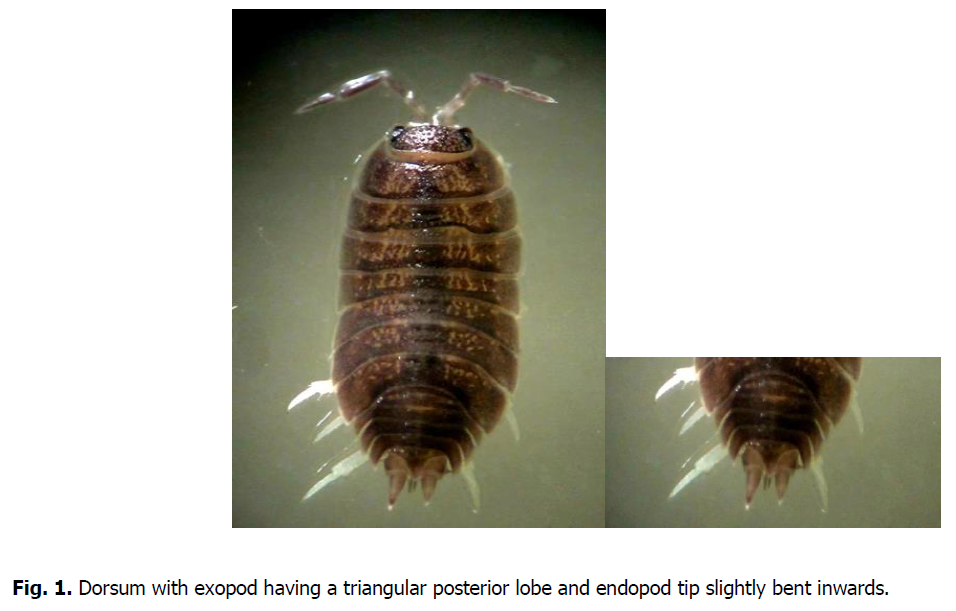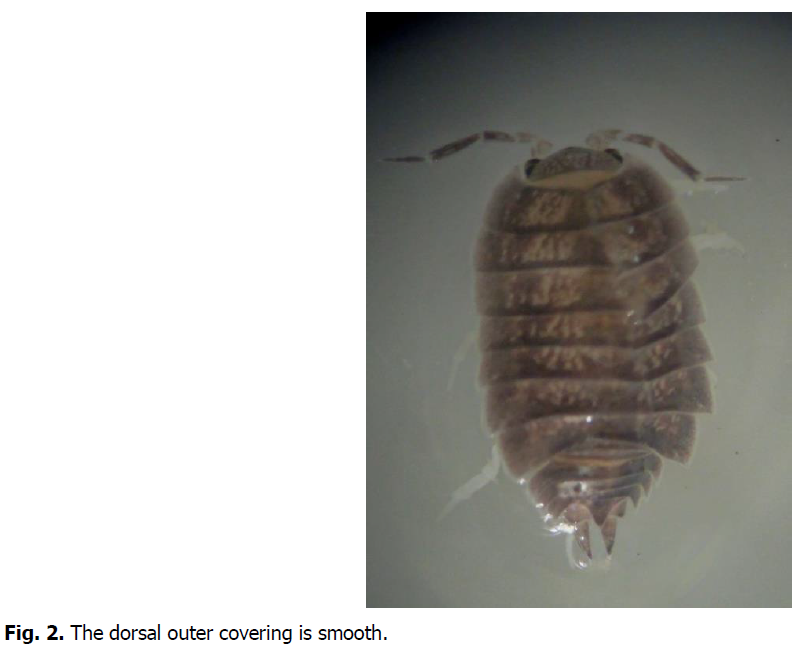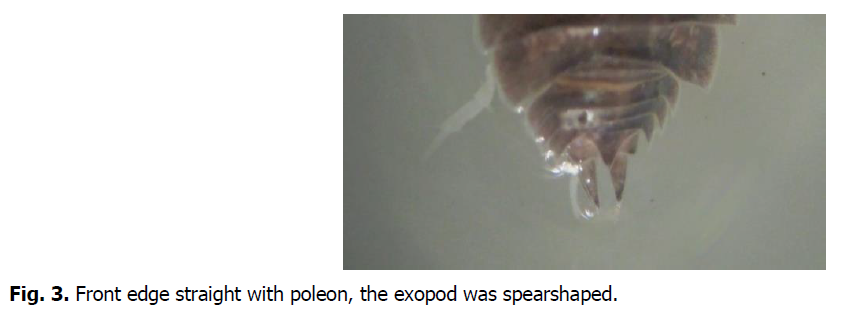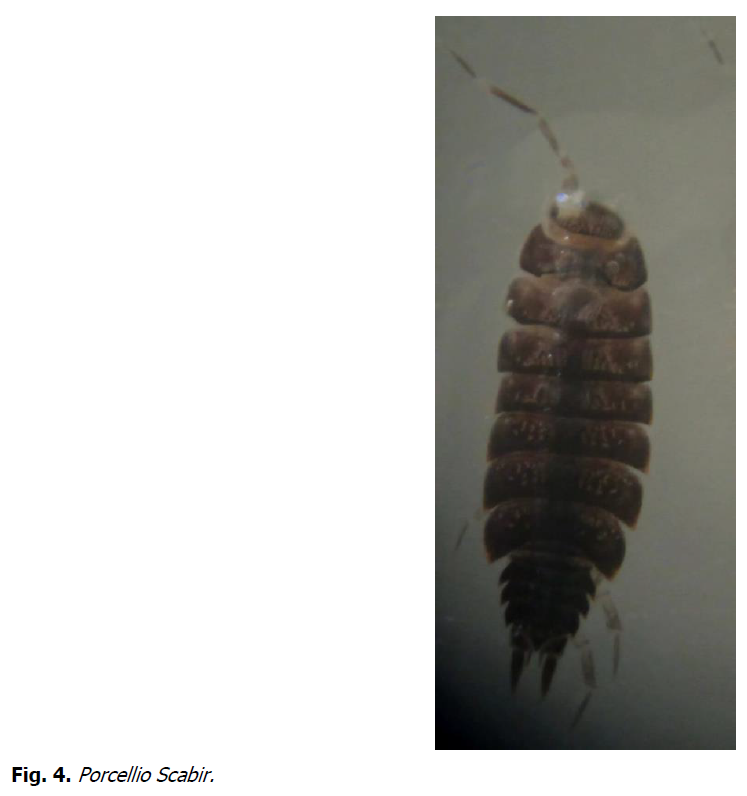Research - (2024) Volume 14, Issue 5
Study of species of Isopods from areas of Basrah Governorate, Iraq (Crustacea: Oniscidea), with descriptions of three record species
Nada Mofeed Al-Baghdadi*, Intisar Mohammed Ali Jabbar, Khaled Khasaf Al-Khafaji, Mayada Hussein Ahmed and Ahmed Jary AL-ShemaryAbstract
The current study was conducted to record three isopods species for first time in wetlands areas- in Basrah south of Iraq, 943individuals of the three species were collected for the period from January to December 2022 from some areas of Basrah Governorate, occurrences of three species in study areas: (Porcellionides pruinosus, Procellio laevis and Procellio scaper). These three species belong to the familliy (Procellionidae).
The highest occurrence rate of the three species was recorded for Porcellionides pruinosus 418(44.32%), Porcellio Leavis 292 (30.96%) and Procellio scaper, 233 24.72 due to several environmental factors that may have caused their monthly numbers to increase or decrease, including an increase in their numbers in the spring and summer months and a decrease in their numbers in the winter months in current study. As well as the difference in appearance from different areas for collecting samples as due for organic matter and moisture available in their soil.
Keywords
Isopods, Shatt Al-Arab River, Basrah, Iraq.
Introduction
Among the edaphic organisms, the terrestrial isopods are fundamental representatives of the soil fauna, playing an important role in decomposition of leaf litter and in mineralizing of organic matter (Sutton, SL. 1980). This paper deals with terrestrial isopods collected in banks of shatt Al-Arab River during a biodiversity survey, with in the scientific cooperation program with the Iraqi Ports Directorate.
The terrestrial isopod in Iraqi areas have been studies in past by several authors Naser, MD. et al., (2015) were recorded the Littorophiloscia culebrae from Khor Al-Zubair, Iraq and the Persian Gulf. During the years 1966-1971, studies have been made on six species of southern Iraq (Basrah region). The climate conditions such as temperature and humidity were high, while the salinity of the soil was highest when the specimens were collected from garden grass, wood.
Isopoda is one of the largest groups belonging to the subphyla Crustacea, to the class Malacostraca, the subclass Eumalacostraca and to the higher order Peracarida, of which about (2450) species have been diagnosed, most of which inhabit the coastal and freshwater environment, while some live in various terrestrial environments. With nearly (500) species, these species are distributed in ten sub-orders, the most prominent of which is the order Oniscidea, known as Terrestrial isopoda or woodlice and it includes (17) families, the most important of which are the families Armadillididae and Procellionidae, as the second includes species belonging to the genus Procellio, known as Sow bugs (Martin, JW., et al., 2005; Al-Moussawi, EJ. 2009; Al-Amin, N. 2011; Al-Salman, IM. 2012).
Among most important taxonomic characteristics of Isopods is the fusion of the first surface segment (and rarely the second) with the head, dorsal ventral compression, absence of carapace, sessile compound eyes. Monophyte and Antennae have atrophic Expodite and there are pairs of Maxillipedes and Thoracic appendages that are largely identical without clear differentiation, unlike Amphipoda which have a functional specialization for their different legs. Abdominal appendages are plate-shaped and thin, stacked on top of each other in the form of book pages. The last abdominal segment fuses with the telson. In males, the first and second ventral appendages mutate into gonads. Males are usually larger than females. The wild isopod individuals are characterized by the presence of a marsupium brood pocket to protect the young, consisting of broad plates on the isiopodite of some thoracic appendages and protruding towards the inner face of a table above each other, forming the floor of the brooding pocket, while the sternum pectoral plates are the roof of this pocket (Appel, C., et al., 2011). Several taxonomic and ecological studies have been conducted on wild isopods in the Arab countries, including Zeini, AH. (2019) which collected samples of wild isopod crustaceans randomly from different regions of Lattakia. The results of his taxonomic study showed the registration of (6 species) of crustaceans, (5) of which were recorded for the first time in Syria, namely, Armadillium vulgare; Armadillo officinalis; Procellio laevis; Procellio scaber; Procelliondes pruinosus and the last species already recorded is Ligia italic. These species were described phenotypi cally and their existence was linked with the most important environmental factors that affect their distribution, such as temperature and humidity.
Due to the lack of studies on wild crustaceans spread in the humid areas of Basrah Due to the lack of studies on wild crustaceans spread in the humid areas of Basra Governorate, the current study aimed to study the types of wild isopod crustaceans for the purpose of benefiting from them in laboratory, environmental and subsequent studies. Governorate, the current study aimed to study the types of wild isopod crustaceans for the purpose of benefiting from them in laboratory, environmental and subsequent studies.
Materials and Methods
Collecting samples of terrestrial Isopoda requires knowledge of their environment, as they appear frequently in humid areas and prefer to be found under stones, among rotten leaves and bark and in soil rich in organic matter. Samples were collected during the period from January to December 2022 by digging at the bottom of stones in wetlands in Basra Governorate, including (Al-Deir area, Sinbad area and Al-Salihiya area). Samples were preserved in the field using 80% alcohol, in plastic containers, indicating the location, date and temperature of the samples collected. The isopod species were taxonomically identified based on used the morphological analysis by (Erhard, F. 1998; Schmidt, C. 2008 and Shultz, JW. 2018). Classifications have been adopted according to some of the following morphological characteristics for the purpose of classifying species: such as body color. Head shape and vertical lobes. The dorsal and ventral plates and the shield.
Results and Discussion
During the period from January to December 2022 (943) individuals of wild Isopoda crustaceans were collected from sampling areas as shown in Table 1. As a result of the examination, three species of terrestrial crustaceans’ isopoda were found, as Table 2 shows the taxonomic position of these crustaceans.
| Terrestrial Isopoda Species | No. of Appearance | % |
|---|---|---|
| Porcellionides pruinosus | 418 | 44.32 |
| Porcellio leavis | 292 | 30.96 |
| Porcellio Scaber | 233 | 24.72 |
| Total | 943 | 100 |
Table 1. Number and percentage of appearance of species collected from wet land in different areas of Basrah city.
| Kingdom: Animalia | Species |
|---|---|
| Phylum: Arthropoda Order: Isopoda Family: Porcellionidae |
Genus: Porcellionides Species: Pruinosus (Brandt, 1833). Genus: Porcellio Species: Procellio laevis (Latreille, 1804). Genus: Porcellio Species: Scaber (Laterllile, 1804). |
Table 2. The taxonomic position of the three isopods recorded in the current study.
Dentification
Family: Procellionidae (Brandl, 1831)
Porcellionides pruinosus (Brandt, 1833): Porcellionides pruinosus (Fig. 1) is a medium sized (to 12mm body length) woodlouse of distinctive appearance (and habitat). It is typically a purplish-brown in colour with a characteristic blue-grey bloom (but rarely may it be orange). The body colour contrasts against the long whitish legs and the pale annulations on the antennae. The body has an obviously stepped outline allowing rapid movement, the antennal flagella comprising two segments and with two pairs of pleopodal lungs. These specimens certainly belong to the genus and subgenus Porcellionides. This species is morphologically close to P. pruinosus from which it differs in the more granulated dorsum with exopod having a triangular posterior lobe and endopod tip slightly bent inwards. Many specimens were examined, we illustrate the main characters of this species (Fig. 1).
Fig 1. Dorsum with exopod having a triangular posterior lobe and endopod tip slightly bent inwards.
Procellio laevis (Latreille, 1804) (Fig. 2): Procellio laevis (Latreille, 1804) shows that the body is oval in shape, wide in front and narrows towards the back and it is difficult to distinguish between the chest area and the abdominal area (there is no reduction between the thoracic segments and the abdominal segments). The dorsal surface is smooth without any ridges. The body color is brown and the eyes are black. The side lobes of the head are visible, while the frontal lobe is not prominent and the posterior edge is not. The posterior edge of the first thoracic segment is slightly concave. The type is rare. The general description agrees with Zeini, AH. (2019) in terms of its height and the abundance of its individuals during the spring and summer months, as the results showed that the rate of appearance of this. The dorsal outer covering is smooth (Fig. 3) front edge straight with poleon, the exopod was spearshaped (Fig.3), this compatible with (Schmalfuss, H. 2011; Taiti, S., et al., 2008).
Fig 2. The dorsal outer covering is smooth.
Fig 3. Front edge straight with poleon, the exopod was spearshaped.
Porcellio Scabir (Laterelle, 1804) (Fig. 4): Porcellio scaber is a large (to 17 mm body length) woodlouse with a rough, heavily tuberculate body with a continuous/smooth outline, the antennal flagella comprising two segments and with two pairs of pleopodal lungs. Although usually slate-grey in colour there are numerous colour forms included brightly mottled varieties (see images). In these forms the pattern is random and not arranged longitudinally as seen in the similar looking P. spinicornis or Trachelipus rathkii. shows that the body is oval, wide in front, narrows towards the back and it is difficult to distinguish between the chest and abdomen (the waist is not present). The color is reddish brown or grey. The head is three-lobed (the frontal lobe is triangular in shape). The pneumatic whip consists of only two pieces. The surface of the body is rough due to the presence of a large number of tubercles. The outer legs of the caudal leg are clearly visible behind the abdominal end and are more linear with a pointed end and shorter in length than in Porcellio leavis species. This species ranks second in terms of distribution, as it has a narrow environmental adaptation and is particularly widespread in gardens rich in organic matter and on tree trunks (Zeini, AH. 2019). One of the characteristics of this species is that there are two pairs of clear lungs in living individuals with a transparent body and they are difficult to see in individuals preserved in preservatives. The endopod and exopod are small white the telson was distinguished by its wide and triangular basal (Fig. 5). The results of this study were consistent with (Taiti, S. 2015).
Fig 4. Porcellio Scabir.
Fig 5. The endopod and exopod are small white the telson was distinguished by its wide and triangular basal.
Conclusion
The genus Porcellionides (Miers, 1877) with the woodlouse species Porcellionides pruinosus (Brandt, 1833), Procellio laevis (Latreille, 1804) and Porcellio scaber (Laterelle, 1804). They are formally new to the Iraqi faunistic list in list in the city of Basrah, We have suggested that these species may have arrived here through human activity. We recommend studying other species and making an annual inventory of the species present in the different environments of Iraq.
Acknowledgement
First, I would like to thank the management of the Marine Science Center for providing all available capabilities to facilitate the completion of the research and include it in the scientific plan of the center. I also thank everyone who contributed to this study and our fellow researchers and providing possible assistance in the Marine Biology Department of the Marine Science Center at the University of Basrah, Iraq.
Ethical Statement
It is important to state my personal beliefs and values. Some examples of a code of ethics include integrity, altruism, honesty, loyalty, equality, fairness, compassion, respect and self-respect. Honesty in dealings and not violating the rights of others in all areas of life.
Data Availability
All available data are presented in the article.
Informed Consent Statement
All participants in the research consented.
Conflict of Interest
We, the authors, declare no conflict of interest.
Authors’ Contribution
The first and second researchers wrote the scientific research and brought the samples, the third researcher photographed the organisms and the fourth and fifth researchers translated and modified the language in the scientific research. All authors critically reviewed the manuscript and agreed to submit final version of the manuscript.
References
Sutton S.L. (1980). Woodlice. Oxford: Pergamon Press 144.
Naser, M. D., Khalaf, T. A., Yasser, A. G. (2015). First record of the terrestrial isopod Littorophiloscia culebrae (HF Moore, 1901) (Isopoda, Oniscidea) from Khor Al-Zubair, Iraq and the Persian Gulf. Crustaceana, 88:611-615.
Google Scholar, Crossref, Indexed at
Martin, J. W., Davis, G. E. (2001). An updated classification of the recent Crustacea. Los Angeles: Natural History Museum of Los Angeles County 39:129.
Al-Moussawi, E. J. (2009). A study of population dynamics and secondary production of four species of Isopods in the Jadiriyah region Baghdad, Iraq. College of Science for Girls University of Baghdad Iraq 98.
Al-Ameen, N. (2011). Using of Porcellio sp. as a bioindicator to mueasuring thelevel of some heavy metal pollution in Baghdad city. Iraqi Journal of Science 52:415-419.
Al-Salman, I. M. (2012). Testing the ability of P. pruinosus (Brandt 1833) Isopoda Crustaceans to decompose and consume cellulosean wastes in different ecosystems. Baghdad Science Journal 9:397-405.
Google Scholar, Crossref, Indexed at
Appel, C., Quadros, A. F., Araujo, P. B. (2011). Marsupial extension in terrestrial isopods (Crustacea, Isopoda, Oniscidea). Nauplius 19:123-128.
Google Scholar, Crossref, Indexed at
Zeini, A. H. (2019). Taxonomical study of Terrestrial Isopods (Crustacea) in some regions of Lattakia. Tishreen University Journal, Biological Sciences 11:11-7.
Erhard, F. (1998). Phylogenetic relationships within the Oniscidea (Crustacea, Isopoda). Israel Journal of Ecology and Evolution 44:303-309.
Google Scholar, Crossref, Indexed at
Schmidt, C. (2008). Phylogeny of the terrestrial Isopoda (Oniscidea): A review. Arthropod Systematics & Phylogeny 66:191-226.
Google Scholar, Crossref, Indexed at
Shultz, J. W. (2018). A guide to the identification of the terrestrial Isopoda of Maryland, USA (Crustacea). ZooKeys 207.
Google Scholar, Crossref, Indexed at
Schmalfuss, H. (2011). Redescription of Porcellio brevicaudatus Brandt, 1833 (Isopoda: Oniscidea); with some notes on other synonyms of Hemilepistus reaumurii (Milne-Edwards, 1840).
Google Scholar, Crossref, Indexed at
Taiti, S., Gruber, G. A. (2008). Cave-dwelling terrestrial isopods from Southern China (Crustacea, Isopoda, Oniscidea), with descriptions of four new species. Research in South China karsts. Memorie del Museo Civico di Storia Naturale di Verona, Monografie Naturalistiche 3:101-123.
Taiti, S., Rossano, C. (2015). Terrestrial isopods from the Oued Laou basin, north-eastern Morocco (Crustacea: Oniscidea), with descriptions of two new genera and seven new species. Journal of Natural History 49:2067-2138.
Google Scholar, Crossref, Indexed at
Author Info
Nada Mofeed Al-Baghdadi*, Intisar Mohammed Ali Jabbar, Khaled Khasaf Al-Khafaji, Mayada Hussein Ahmed and Ahmed Jary AL-ShemaryCitation: Al-Baghdadi, NM., Jabbar, IMA., Al-Khafaji, KK., Ahmed, MHA., AL-Shemary, AJ. (2024). Study of species of Isopods from areas of Basrah Governorate, Iraq (Crustacea: Oniscidea), with descriptions of three record species. Ukrainian Journal of Ecology. 14:9-15.
Received: 03-Sep-2024, Manuscript No. UJE-24-148413; , Pre QC No. P-148413; Editor assigned: 05-Sep-2024, Pre QC No. P-148413; Reviewed: 17-Sep-2024, QC No. Q-148413; Revised: 23-Sep-2024, Manuscript No. R-148413; Published: 30-Sep-2024, DOI: 10.15421/2024_573
Copyright: This is an open access article distributed under the terms of the Creative Commons Attribution License, which permits unrestricted use, distribution, and reproduction in any medium, provided the original work is properly cited.





